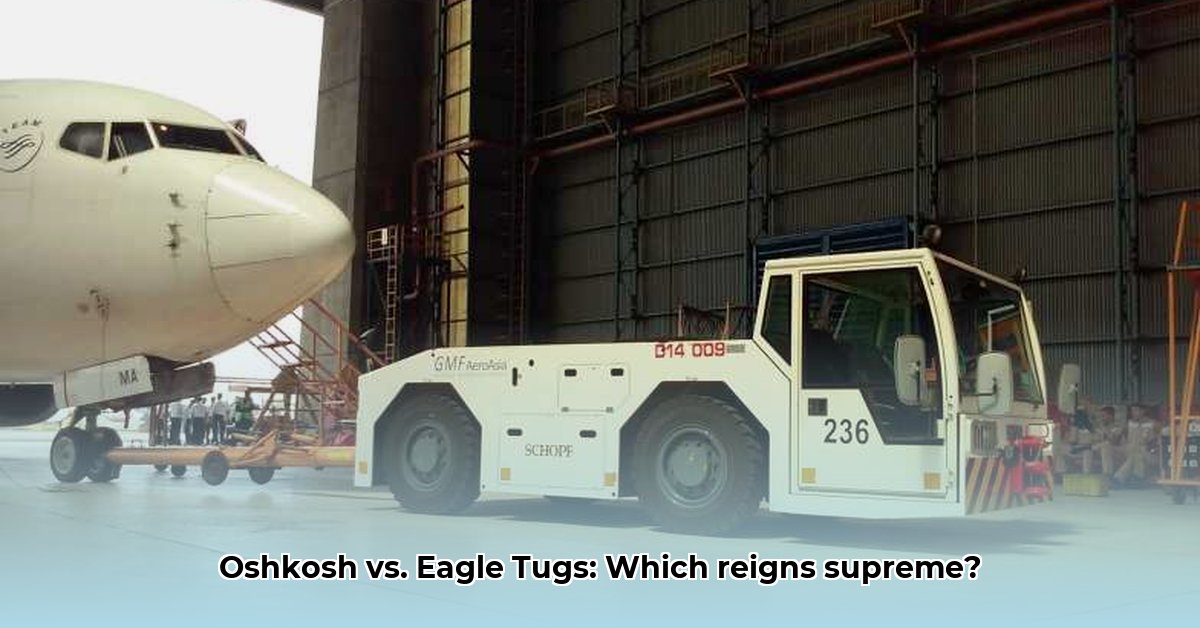
Choosing the right aircraft tow tractor is critical for airport efficiency and safety. This comparative review analyzes Oshkosh AeroTech and Eagle Tugs, two leading manufacturers, to help you make an informed decision. We'll examine towing capacity, drive systems, power sources, and crucial real-world considerations. Understanding these factors is vital for optimizing your airport's ground support operations. For a deeper dive into other tractor options, see this tractor comparison.
Towing Capacity and Aircraft Compatibility
Oshkosh AeroTech boasts models capable of towing aircraft weighing up to 135,000 lbs, showcasing impressive heavy-duty capabilities. However, Eagle Tugs provides a broader range of tractors to accommodate various aircraft sizes, from smaller general aviation aircraft to larger commercial jets. The optimal choice hinges on your airport's specific aircraft fleet and operational needs. What is the average weight of aircraft at your facility? This question should guide your decision significantly.
Drive Systems and Maneuverability
Both Oshkosh and Eagle Tugs offer all-wheel drive (AWD) and four-wheel drive (4WD) systems, enhancing traction and stability. However, Oshkosh frequently incorporates optional four-wheel steering (4WS), greatly improving maneuverability in confined spaces. Eagle Tugs also features 4WD and 4WS in select models, particularly within their ETT and XL series. Consider your airport's layout – do tight turning radii and precise maneuvering outweigh the initial cost of 4WS?
Power Source: Diesel vs. Electric
The choice between diesel and electric power sources is significant. Oshkosh AeroTech prominently features its electric LEKTRO models, highlighting their environmental benefits and the longevity of their lithium-ion batteries. Eagle Tugs also offers a selection of electric tugs, primarily in their ETT line, emphasizing sustainable operations. However, a thorough analysis of battery technology, recharge times, and operational range is crucial before committing. What are the long-term energy costs associated with each option in your specific operating context? This is a key factor in Total Cost of Ownership (TCO).
Head-to-Head Comparison: Key Features
The following table summarizes key differences. Note that specific features vary across models, so consulting manufacturer specifications is essential.
| Feature | Oshkosh AeroTech | Eagle Tugs |
|---|---|---|
| Towing Capacity | Up to 135,000 lbs (or higher depending on model) | Varies significantly by model |
| Drive System | AWD, 4WD, optional 4WS | AWD, 4WD, 4WS in selected models |
| Power Source | Diesel and Electric (Lithium-ion batteries) | Diesel and Electric (various battery technologies) |
| Typical Customer | Larger airports, defense organizations | Broader range, including smaller airports |
| Customization Options | Highly customizable | Generally less extensive customization options |
Real-World Considerations: Beyond Specifications
Oshkosh's extensive experience with defense contracts translates to robust construction and advanced safety features, meeting stringent military standards. This is particularly valuable for high-security airports. Eagle Tugs' broader customer base may result in wider service network accessibility and potentially faster parts procurement, minimizing downtime.
Choosing the Right Tractor: Weighing the Pros and Cons
The optimal choice depends on your specific needs.
Oshkosh AeroTech:
- Pros: Exceptional towing capacity, robust construction, extensive customization, proven military pedigree.
- Cons: Higher initial cost, potentially smaller dealer network, may be excessive for smaller airports.
Eagle Tugs:
- Pros: Wide range of models, potentially lower initial cost, potentially larger service network.
- Cons: May have lower power and customization options than Oshkosh for the largest aircraft, potentially fewer specialized safety features.
Before making a decision, obtain detailed specifications from both manufacturers and, if feasible, request on-site demonstrations. Thorough due diligence is crucial for this significant investment. Ongoing technological advancements in battery technology and increased emphasis on safety regulations should also factor into your long-term considerations.
Deep Dive into Battery Performance: Oshkosh vs. Eagle Tugs
Choosing between Oshkosh and Eagle Tugs may ultimately come down to battery performance for those considering the electric options. While direct comparison of battery specifications requires detailed manufacturer data, we'll review key factors to consider:
Battery Capacity (kWh): Higher capacity means longer operation, but this increases cost and weight.
Charging Time: Faster charging minimizes downtime. Compare charging times from 0% to 100% under typical conditions.
Operating Conditions: Temperature, terrain, and load significantly affect battery life and range. Real-world data is needed.
Battery Management System (BMS): A sophisticated BMS extends battery life and enhances safety.
Total Cost of Ownership (TCO): Includes purchase price, energy costs, maintenance, and battery replacement.
Beyond raw battery specifications, consider maintenance schedules, charging infrastructure requirements, safety features, and scalability when making your decision. A comprehensive cost-benefit analysis is crucial to avoid unforeseen expenses down the line. Remember, the best tractor is the one that aligns perfectly with your airport's unique operational needs and long-term budget.